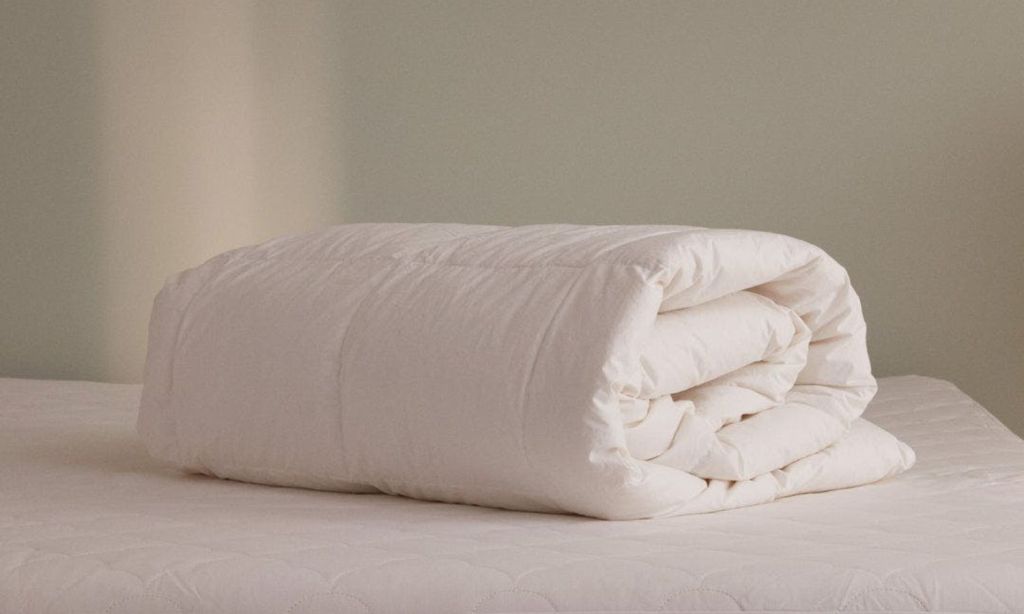Products featured are independently and objectively selected by our editors. From time to time, things you buy through our links may earn us an affiliate commission.
Navigating the doona category can be overwhelming, with its breadth of options — ranges of price points, materials and performance.
To help you understand all the options for doonas so you can best choose which is right for you, we tapped Caitlin Hogg, Design and Production Manager at Australian bedding company Sheet Society. Ahead, we share Hogg’s answers to three questions we’ve always wondered about doonas, but never known the answers to.
Plus, keep scrolling to shop some of our favourite doonas right now.
What Are the Different Types of Doonas?
“As a general overview, doona options are down and feather, wool, cotton, bamboo or synthetic, like polyester,” says Hogg.
“Down and feather, which come with a higher price tag, have traditionally been the most popular based on loft and warmth performance. They also offer longevity — with use for up to 10 years. Cotton or bamboo are great options for those looking for a lower investment or buyers can look to polyester microfibers as a vegan alternative that’s easily accessible.”
What Should You Look For in a Year-Round Doona?
“When investing in an all-round quilt, you should always be looking for a natural fibre quilt that will regulate your body temperature,” says Hogg. “Understanding the TOG rating of your desired quilt will also determine if it is suitable for multi-season purposes. I suggest a 7.5, as a general rule of thumb.”
If you’re not familiar with what TOG stands for, it’s Thermal Overall Grade, a unit of measurement used to calculate the thermal insulation and warmth of a product. The lower the TOG rating, the lighter the fabric. The higher the rating, the more padded and insulated it is. You’d opt for a higher TOG rating for a colder climate.
“That said, no two sleepers are the same and your sleep environment can have a huge effect on what all-round means to the individual. You should look to quilts that are weight/TOG adaptable to suit the climate and type of sleeper you are.”
How Often Should You Replace Your Doona?
“Replacing your quilts is important for the health and quality of your sleep,” says Hogg.
“There are many factors that impact when your bedding needs to be replaced, that being how often you use the product, along with how you care for it and what type of sleeper you are.
“For a plant-based quilt such as cotton or bamboo, we’d recommend looking to replace it every 5-7 years if you use them every day. In comparison, a well-cared-for 100% down quilt can last up to 10 years.”
What Are Some of the Best Doonas in Australia, Currently?
Here’s what we’re loving doona and duvet-wise on the market right now.
Bonny All-Rounder Doona, $399
This year-round doona features 90% down filling, 400-thread count and 100% cotton casing. Its materials were also ethically sourced and certified so you can sleep easy knowing you’re being nicer to the planet.
I Love Linen Hotel Cloud Collection 5-Star Hotel Quilt, now $219, was $370
This is a year-round quilt option, filled with microfibre that feels like feathers and silk. The doona was made by a design team who consulted with luxury hotels and spent nearly a year on the development.
Koala Balmy Night Duvet, $185
Meant for use in summer, this doona is filled with polyester material, while its cover is made with fibres sourced from sustainably-farmed wood, as well as cotton.
Sheet Society Low Down Medium Weight Quilt, $400
The bedding brand’s Low Down range includes your choice of Medium Weight or Light Weight quilts. Both are great for sleepers who don’t get too cold or too hot when they sleep, or who live in mild climates. They’re also both filled with 100% recycled down and feather.
Related: This IKEA Bedtime Hack Is the Secret to a Good Night’s Sleep (and Fewer Fights)
Related: This New Hotel in Mexico’s Riviera Maya Has Boho Home Inspo For Days
Read more stories from The Latch and subscribe to our email newsletter.

